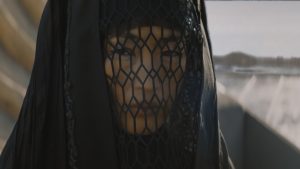
Doctor Who has thousands of unproduced story concepts. Indeed, the first ever story ‘An Unearthly Child’ was based on a completely different idea: C.E. Webber’s ‘The Giants’, in which the Doctor and co. would have been shrunken down and faced comparatively massive Earth insects, was in an original series document produced for Doctor Who, and had Rex Tucker assigned to direct.
‘The Giants’ was vetoed for a combination of technical reasons: the small and outdated studio assigned to Doctor Who wasn’t up to the task of giant insects. Said insects drew the ire of Doctor Who co-creator Sydney Newman, who famously disliked bug-eyed monsters – you can’t get any more bug-eyed than literal bugs. Aspects of it ended up in the Season 2 story ‘Planet of Giants’, and the opening scene – where teenager Sue and her teachers Cliff and Lola meet Dr Who (sic) in the fog – was adapted for David Whitaker’s novelisation of the first Dalek story.
The history of Doctor Who is littered with alternate takes, concepts and roads not travelled. Here are some of the most memorable.
Gender Politics and Brainwashing
One of Doctor Who’s most notorious unmade stories is ‘The Prison in Space’ by Dick Sharples, considered for season six in 1968. The TARDIS lands on a planet where women rule and men are disenfranchised. The Doctor and Jamie are sentenced to imprisonment by President Babs and are sent to a satellite run by “The Dolly Guards”. Zoe is brainwashed to support the regime but only after accidentally inciting revolution. Zoe does this by explaining how well men and women on Earth can live together without any problems, which is a bold claim. It is worth highlighting that Zoe comes from the future and so maybe human civilisation has become more utopian, but it also worth highlighting that Zoe: A) Was educated to mega-genius level by extreme mental and physical conditioning, and so may not be a reliable guide, and: B) Isn’t real.
At any rate, Jamie undoes the brainwashing by spanking her.
Big Finish adapted the story in 2010, which was certainly a choice.
Sentient Mud, Nessie & a Living Planet
In 1964 Victor Pemberton submitted ‘The Slide’ (in which the Doctor discovered sentient, mind-controlling mud) to the Doctor Who production offices. The story was rejected and so Pemberton adapted it for BBC radio. ‘The Slide’ was then adapted back into a Doctor Who story that swapped the mud for seaweed in 1968’s ‘Fury from the Deep’.
Donald Cotton, who wrote two Hartnell stories, submitted a third which contained the idea that the Loch Ness Monster was of alien origin. ‘The Herdsmen of Venus’ suggested that the Loch Ness Monster was in fact a type of space bovine, bred by the titular herdsmen, and raising the very real possibility of a space helmet for a cow. Cotton’s story was rejected by the a new production team who felt Doctor Who should be a serious show, though seemingly conflicting alien origins for the Loch Ness Monster would appear in 1975’s ‘Terror of the Zygons’ and 1985’s ‘Timelash’.
Alan Wakeman reportedly resubmitted spurned 1960s story idea ‘The Living Planet’ to Doctor Who in 2005. Based on soon-to-be abandoned character concepts for the Doctor’s granddaughter Susan, this story saw the TARDIS land on a planet covered in small edible hexagons that attacked flying metallic fish.
The Doctor IS the Master?
‘The Final Game’, by Robert Sloman, was to have been Roger Delgado’s final story as the Master. The Doctor and the Master would be revealed as two aspects of the same person: the ego and the id. The idea that they were brothers was also discussed, and referenced in ‘The Sound of Drums’ (2007). At the story’s end The Master would die in an explosion, but the script left it ambiguous as to whether or not he was sacrificing himself to save the Doctor. Delgado’s tragic death in 1973 meant ‘The Final Game’ couldn’t happen, so Sloman wrote ‘Planet of the Spiders’ as a capstone to the Pertwee era instead.
A huge ‘What if…’ in Doctor Who history is ‘The Lost Legion’, a story by regular director Douglas Camfield featuring aliens attacking the French foreign legion, ended with the death of companion Sarah Jane Smith. Script Editor Robert Holmes was unhappy with the script, and decided to bring back another rejected script – ‘The Hand of Fear’ – where the original draft killed off The Brigadier. UNIT were being phased out of the show in the mid-Seventies, and the plan was to send the Brig out in a blaze of glory. This was considered for ‘Pyramids of Mars’ in 1975, and ‘The Hand of Fear’ would have seen him stop the destruction of Earth in an explosive act of self-sacrifice. Sarah’s death, at the hands of the last surviving alien antagonist, would have been followed by her body being burnt on a funeral pyre as the Doctor left in the TARDIS.
Perhaps there was a sign up in the mid-Seventies production office that simply read ‘Better Immolate Than Never’.
Ultimately these stories were rejected, and 1989’s ‘Battlefield’ would also consider killing off the Brigadier, but writer Ben Aaronovitch reportedly found that he couldn’t write that scene. Sarah Jane and the Brig would return to Doctor Who and its spin-offs, their characters only passing with their actors.
The Missing Season 23
Colin Baker has a fair few missing stories, with Season 23 in pre-production when the show was temporarily cancelled, and a whole series binned. ‘The Nightmare Fair’ by former producer Graham Williams was to be the opening story, featuring the return of The Celestial Toymaker (as seen in 1966’s ‘The Celestial Toymaker’ and 2023’s ‘The Giggle’) at Blackpool Pleasure Beach. Philip Martin had written ‘Mission to Magnus’, bringing back the return of the Ice Warriors after twelve years, and the character Sil from Martin’s last story ‘Vengeance on Varos’. Robert Holmes had outlined a story set in Singapore featuring the return of the Master, the Rani and the Autons.
Season 23 became a single 14-episode story, ‘The Trial of a Time Lord’, effectively three stories with the Doctor’s trial as a framing device, concluding with a two-part finale. The third segment proved especially tricky. Initially David Halliwell and Jack Trevor Story were commissioned to both write two-parters set in the same location, with Halliwell’s script concerning two animal-like races in escalating conflict on the planet Fred. Story, though, struggled with his two episodes and Halliwell’s weren’t popular with the production team.
Former Script Editor Christopher Bidmead wrote ‘Pinacotheca’ – about a museum of key moments in the history of the universe – and after working closely with Eric Saward on the scripts, was surprised to hear nothing for a month before the scripts were rejected. Saward turned to PJ Hammond, creator of Sapphire & Steel and future Torchwood writer, who quickly wrote ‘Paradise Five’ about a sinister holiday camp planet, but producer John Nathan-Turner didn’t like it. Nathan-Turner met Season 22 writers Pip and Jane Baker in a lift and suggested Saward talk to them. Saward resigned shortly afterwards, and Nathan-Turner script edited the Bakers’ scripts.
A cynical person would say that there was more drama offscreen than on it.
The TV Movie: The Doctor’s Search for his Human Dad
Philip Segal was moving forward with a TV movie version of Doctor Who for FOX, with John Leekley (Spawn: The Animated Series) writing the script. It was to have been a reboot where the Doctor and the Master are half-brothers, with Borusa – one of the Doctor’s tutors in the original show – their grandfather. The TV Movie would have reimagined the Cybermen (or ‘Cybs’) and the story ‘Genesis of the Daleks’ while the Doctor quests for his human father.
Steven Spielberg, Segal’s boss at the time, thought it lacked comedy. Robert DeLaurentis (recently a producer/writer on Fargo) was brought on to rewrite Leekley’s draft. Here the Doctor’s father would have led a squad of American soldiers on a mission to assassinate Adolf Hitler, and the Daleks would be shape-shifting mutants called Zenons. All of which feels like someone said ‘Let’s recreate, in the viewer, that same feeling they had when Sylvester McCoy played the spoons on Kate O’Mara’s chest in ‘Time and the Rani’, only this time with a budget of five million dollars.’
Segal and Fox were not happy with this direction (the BBC also joined in with the ‘Stop that, it’s silly’ feedback) and returned to the last Leekley draft, but when writer Matthew Jacobs was hired it was decided to mostly start from scratch.
Christopher Priest, Stephen Fry & Paul Abbott
Christopher Priest, author of The Prestige and The Inverted World, was asked about writing for the show as part of Script Editor Douglas Adams’ attempts at moving towards harder science fiction. His Gallifreyan political thriller, ‘Sealed Orders’, never saw the light of day after Adams left the show and his successor couldn’t agree on a way forward with Priest.
Christopher Priest was asked about writing for the show again to apologise for ‘Sealed Orders’ being abandoned. ‘The Enemy Within’ was abandoned after Priest was asked to revise his scripts to kill off companion Adric. A disagreement about rewrite fees led to Priest receiving a written apology from script editor Eric Saward and producer John Nathan Turner (the latter described by Priest in a 1995 interview with David Langford as “an appalling little ****”).
Stephen Fry, the popular avuncular posh person, has featured in Doctor Who as C in ‘Spyfall Part 1’ and as The Minister of Chance in ‘Death Comes to Time’ – a 2001 webcast that saw the Doctor sacrifice himself as the last of the Time Lords, leaving Ace to start again, having had Time Lord abilities conferred on her. He also wrote a story for the 2006 series, meeting with fellow writers (as documented by Steven Moffat in Doctor Who Magazine, who mentioned being embraced by Fry but unfortunately being the same height as Fry’s armpit).
Fry was developing a 1920s-set story (after directing a similar setting in the film Bright Young Things) based on the legend of Sir Gawain and the Green Knight (adapted by David Lowery as a 2021 Dev Patel-starring film) but it was too costly to make as part of series two. When pre-production came around for series two, Fry was too busy with other work to do the necessary rewrites and the story was dropped.
Current and 2005-2010 showrunner Russell T. Davies’ initial series plan had a few story outlines that wouldn’t reach the screen until series four in 2009, but the most intriguing What If… for the 2005 series is Paul Abbott’s unused story idea (replaced with ‘Boom Town’) where it would be revealed the Doctor had been manipulating Rose Tyler’s life to make her the perfect companion. Abbott became too busy working on Shameless to develop the script, but it’s unlikely it would have reached broadcast in the same shape.
Lost Stories
These stories are the tip of the iceberg, there are many more out there. Some have been novelised (three of the stories lined up for the original season 23, for example), Anthony Coburn’s ‘The Masters of Luxor’ had its scripts published as part of a Titan Books range in 1992, and Big Finish have adapted many of them as part of their ‘Lost Stories’ range (including the abandoned season 23 and a prospective season 27, had the show not been cancelled in 1989).
We know of a few unmade scripts since 2005, including ones by Mark Gatiss and Tom MacRae, and some early outlines for the original Series 13 will have been lost to the pandemic. If you’re interested, then a whole host of alternative universes are online, ready and waiting for you to find.
Doctor Who returns to BBC One and iPlayer in the UK on Saturday May 11, and to Disney+ around the world on Friday May 10.
The post Doctor Who’s Unmade TV Episodes appeared first on Den of Geek.







